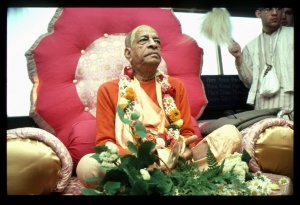BG 13.28 (1972)

A.C. Bhaktivedanta Swami Prabhupada
TEXT 28
- समं सर्वेषु भूतेषु तिष्ठन्तं परमेश्वरम् ।
- विनश्यत्स्वविनश्यन्तं यः पश्यति स पश्यति ॥२८॥
- samaṁ sarveṣu bhūteṣu
- tiṣṭhantaṁ parameśvaram
- vinaśyatsv avinaśyantaṁ
- yaḥ paśyati sa paśyati
SYNONYMS
samam—equally; sarveṣu—in all; bhūteṣu—living entities; tiṣṭhantam—residing; parameśvaram—the Supersoul; vinaśyatsu—in the destructible; avinaśyantam—not destroyed; yaḥ—anyone; paśyati—see; saḥ—he; paśyati—actually sees.
TRANSLATION
One who sees the Supersoul accompanying the individual soul in all bodies and who understands that neither the soul nor the Supersoul is ever destroyed, actually sees.
PURPORT
Anyone who can see three things—the body, the proprietor of the body, or individual soul, and the friend of the individual soul, combined together by good association-is actually in knowledge. Those who are not associated with the soul's friend are ignorant; they simply see the body, and when the body is destroyed they think that everything is finished, but actually it is not so. After the destruction of the body, both the soul and the Supersoul exist, and they go on eternally in many various moving and unmoving forms. The Sanskrit word parameśvaram is sometimes translated as the individual soul because the soul is the master of the body, and after the destruction of the body he transfers to another form. In that way he is master. But there are others who interpret this parameśvaram to be the Supersoul. In either case, both the Supersoul and the individual soul continue. They are not destroyed. One who can see in this way can actually see what is happening.